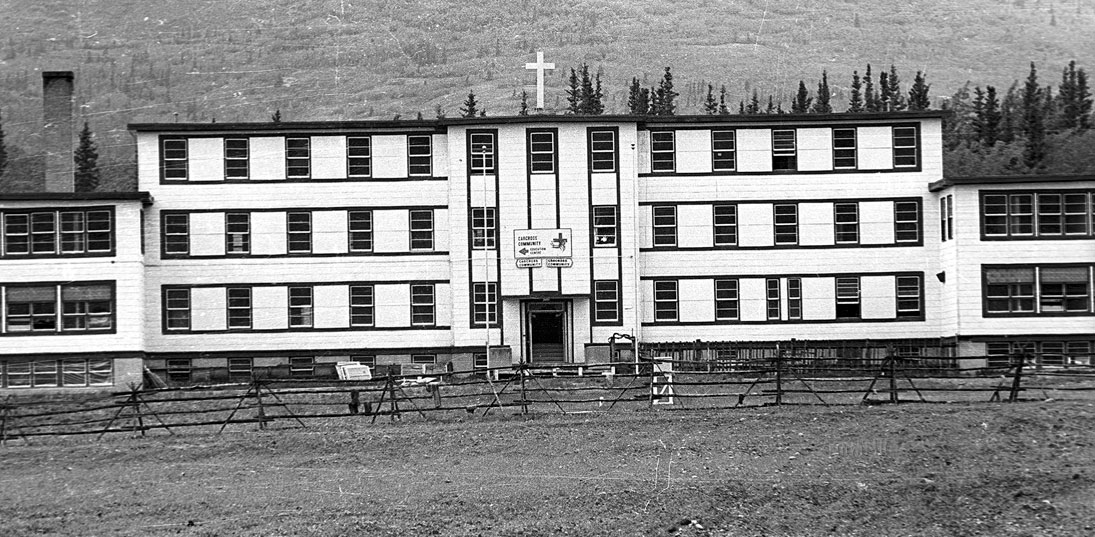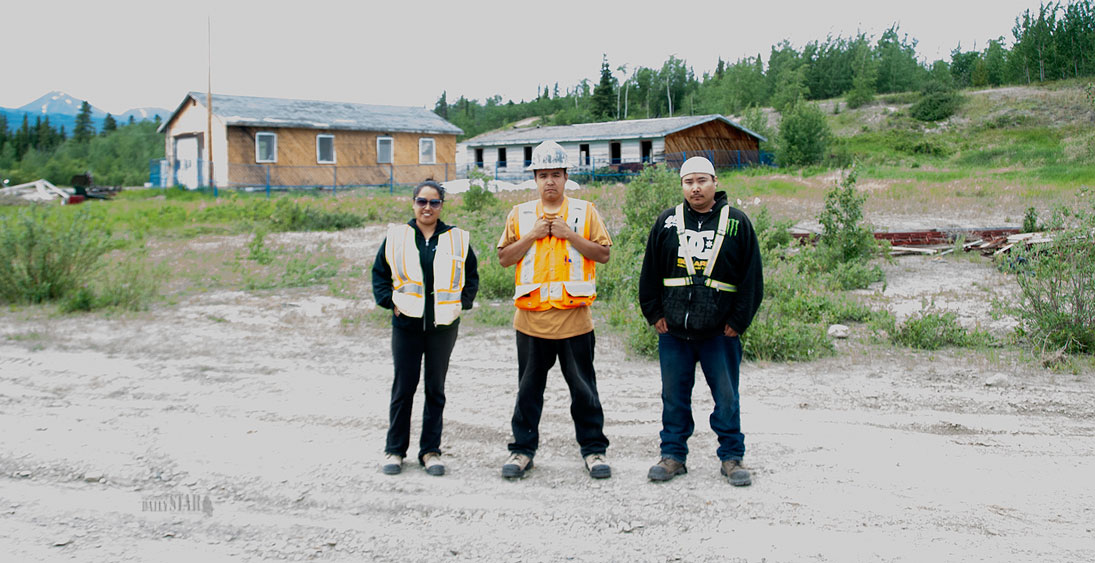
Photo by Whitehorse Star
GONE BUT NOT MISSED – The Chooutla School, near Carcross, is seen in 1980, 11 years after it closed. The residential institution operated from 1911 to 1969.

Photo by Whitehorse Star
GONE BUT NOT MISSED – The Chooutla School, near Carcross, is seen in 1980, 11 years after it closed. The residential institution operated from 1911 to 1969.

Photo by Sidney Cohen
TRANSFORMING A PLACE – Samantha Smith, Tyrone Atlin and Shane Schinkel (left to right) are part of a team of young people cleaning up the site in Carcross formerly occupied by the Chooutla School.
When the last vestiges of the Chooutla School are cleared away, no one will mourn its loss.
CARCROSS – When the last vestiges of the Chooutla School are cleared away, no one will mourn its loss.
The place in Carcross where a residential school once stood remains today a painful site for many in the community, and for survivors and their relatives all over the Yukon.
But a group of Carcross youth have been enlisted to breathe new life into the grassy clearing where suffering is virtually baked into the soil.
From the South Klondike Highway, it’s a few minutes’ drive down a winding dirt road to the small field in a wooded area where the school used to be.
On one side of the dirt road, two condemned, single-storey buildings are encircled in a ring of blue fencing, indicating that the ground here is, literally, poisoned.
Another area is cordoned off as well. There are traces of aesbestos and lead paint in the area, Khà Shâde Héni (chief) Andy Carvill of Carcross/Tagish First Nation told the Star recently.
Men in hazmat suits poke about the derelict buildings. Outside the fence, workers in reflective vests heap scraps of rusty, mangled metal onto a large pile.
Old bed frames, boiler parts, pots and pans have been found several metres into the surrounding forest.
These relics, from a nightmarish period in Canada’s history, are “things I don’t even want to touch,” says Shane Schinkel, who started work at the site two weeks ago.
“But it’s got to be removed by somebody.”
Schinkel is one of about 16 young people from the Carcross/Tagish First Nation who have been hired to remediate and landscape the old Chooutla School grounds.
Unlike at other construction sites, however, neither certification nor previous experience were prerequisites for employment. Rather, workers are trained on the job, and get to try their hand at a number of different trades.
“They’ll spend an intensive morning learning plants identification... and the next thing you’ll be putting on a hazmat outfit and getting rid of asbestos and lead paint and stuff,” said Randy Lewis of R.L. Resource Management Ltd., and the program’s co-ordinator.
Skills taught at the site range from water sampling and remediation to salvaging and demolition.
The entire project was examined and broken down into different training opportunities, explained Lewis. Trainees are encouraged to pursue their interests.
“It’s interesting because you’re learning about all different aspects of one site,” said Samantha Smith, for whom this kind of work is totally new.
Training programs typically have students focus on one trade, said Schinkel.
On this job, however, “you can actually pick and choose what you want to do, what you’re more interested in.
“You come out with a career, and some money,” he said, cracking a smile.
Making over the old residential school site is a chance for the First Nation to build capacity, said Carvill.
It’s one of a few projects the First Nation government has turned into training opportunities for its citizens.
Young people in Carcross also picked up skills working on the community’s brand new Learning Centre, an airy, modern event space and educational hub that opened last month.
“We want to carry on with training and bringing up their skills,” said Carvill.
“We know in Carcross, we’re looking at other environmental remediation projects... so we get them started in the training and then we just move them on to the next job.”
Carvill took Carolyn Bennett, the minister of Indigenous and Northern Affairs Canada, to witness the clean-up of the residential school site when she was in the Yukon last week. The young people working there, said Carvill, “are doing an excellent job.”
They also know that this is no ordinary project.
The Anglican mission school “has had a huge negative impact on a lot of people,” said Smith.
“A lot of our family members are affected by it,” added Tyrone Atlin, a trainee whose father is a former student.
“He doesn’t talk about it,” said Atlin. “Breaks down when he does.”
The Chooutla School opened in 1911, and children there experienced the brutalities ubiquitous to the residential school system.
These included starvation, “unregulated corporal punishment,” and poor living conditions that enabled the outbreaks of diseases such as measles.
One former student, Angela Sidney, told the Truth and Reconciliation Commission (TRC) that “we couldn’t even talk to our brothers! We got punished if we did. And we weren’t supposed to talk Indian, Tlingit.”
Sidney said her sister died at the school. The little girl would be one of more than half a dozen students who died while attending the school, according to the TRC.
The Chooutla School finally closed in 1969, but shadows of it haunt the place it once occupied in Carcross.
“You’ve got to have a strong mental attitude to be doing this stuff,” Schinkel said of cleaning up the school grounds.
“You’re touching a 100-year-old bed that how many kids have slept in and probably hate that bed.
“You start thinking about that stuff.”
For Schinkel, this work is about more than learning trades and earning paycheques.
“It’s like a spiritual venture, really,” he said. “More spiritual than a job.”
What the old residential school grounds will become is still uncertain. A park, gardens, and monument are all under consideration.
The First Nation will set up a working group of Yukon elders and survivors of the school that will make the final decision.
But before the space transitions to something new, said Carvill, it must undergo a spiritual cleansing.
“We’re looking for other people that have gone to the residential school and we want them to get involved in this process and have their input with respect to the ceremony and clean up and how everything should take place,” he said.
Atlin, Schinkel and Smith have some thoughts about what could happen with the site.
“I wouldn’t mind seeing it turned into a park,” said Atlin.
Schinkel suggested “a monument or something, just a reminder of what can go wrong.”
“A place to come heal,” added Atlin.
“Another part of me just wants all the vegetation to take back over, and trees to take over,” said Schinkel. “That would be the best thing for the area.”
“Give it back to the forest,” chimed in Smith.
The hope is that one day, this place will imbue lighter memories than when it was home to a residential school.
“It’s pretty awesome to be part of the team that’s going to be cleaning it up and trying to take a positive out of a negative,” said Smith.
In order to encourage thoughtful and responsible discussion, website comments will not be visible until a moderator approves them. Please add comments judiciously and refrain from maligning any individual or institution. Read about our user comment and privacy policies.
Your name and email address are required before your comment is posted. Otherwise, your comment will not be posted.
Comments (7)
Up 1 Down 1
kathy amundson-forsberg on Aug 9, 2017 at 7:01 pm
I do not know what really happened at the residential school, but when it became the CCEC, it was filled with laughter, love, and learning. When we closed CCEC down, we cleaned out the building and grounds and disposed of contents according to the Yukon Territorial government. We did not leave things lying around - it was a very arduous, painful process, which we took seriously. I still mourn it's loss.
Up 28 Down 2
Just Sayin' on Jul 10, 2017 at 10:35 am
Usually, I am a proverbial ass in my responses in regards to FN issues and the pseudo-equality, but this struck me differently. I think it is amazing what these youths are doing and how they are attempting to heal. These youths/young adults are taking control of the past and doing something positive for the community and those who were abused. Massive amount of respect!
Up 38 Down 2
James on Jul 9, 2017 at 7:27 am
Yes, my memories of the school are positive ones as I was an attendee of the CCEC in the 70s - my thoughts and prayers for healing go out to all the First Nations who were forced to attend through a misguided concept of assimilation and were the victims of abuse.
Up 32 Down 10
Lee Smith on Jul 8, 2017 at 11:09 pm
I was thinking, as I'm reading through this article, that bed that was said to be maybe 100 years old most likely came from old regiments of Carcross Community School. And extremely well run, ultra positive environment, with an abundance of kind, generous, loving, thoughtful activities.
I understand the devastation that took place prior to those wonderful years, but we cannot teach just one side of its story. My heart goes out to those who suffered tragic experiences. Atrocities happened that never should have.
But much good was found there too and we must teach that as well.
Up 46 Down 23
jc on Jul 7, 2017 at 10:41 pm
As a former Residential school member back in the mid 40s, I would just like to know who invents this dribble anyway? How come I and my siblings never experienced any of this? We were housed, fed, clothed, educated. No abuse of any kind that I can remember.
Up 12 Down 21
Rod on Jul 7, 2017 at 6:10 pm
Holy wow...look an article June Jackson hasn't had an opinion on!
Up 42 Down 6
Tammy on Jul 7, 2017 at 5:49 pm
Yes - Carcross had a horrific history with the first nations, but it also had a very positive & happy one as well. No mention of our Carcross community school in the 70's were we lived, loved, laughed, worked, learned, grew and did numerous good will works for the surrounding communities . The memories I have of that special experience that I was lucky to be a part of will forever be a part of my happy place in the Yukon. Lots of good happened there as well as its sad history. Let us not forget that.